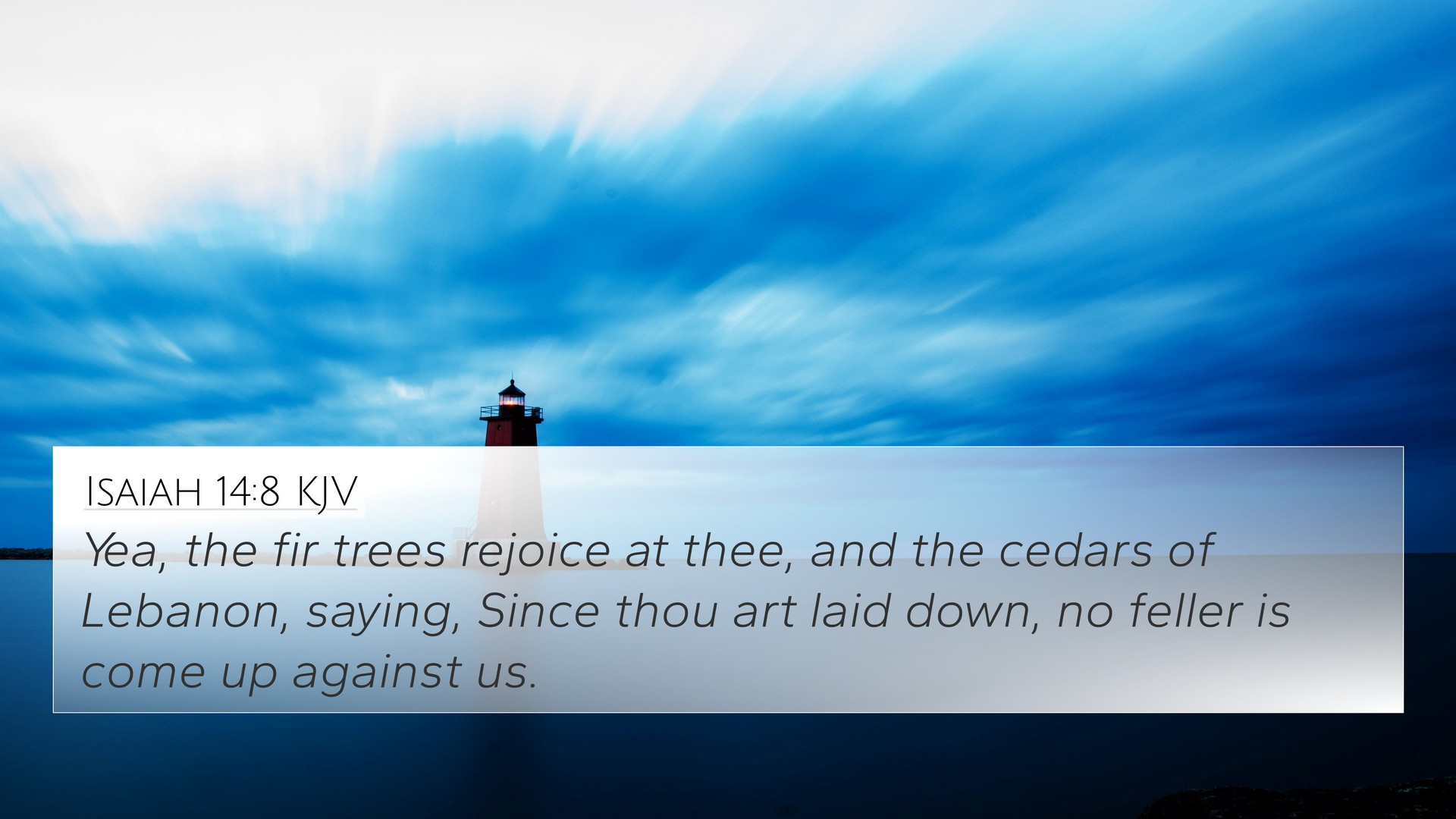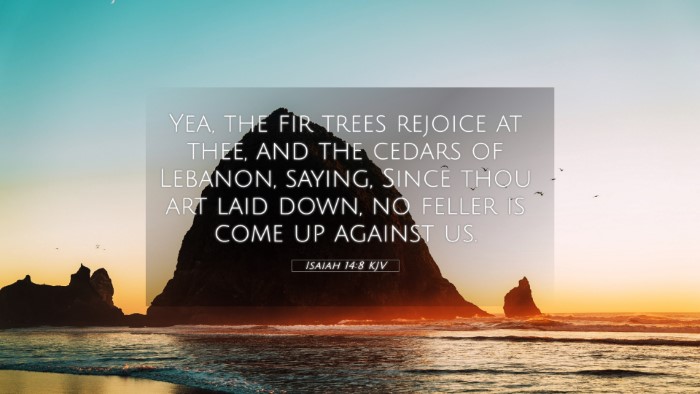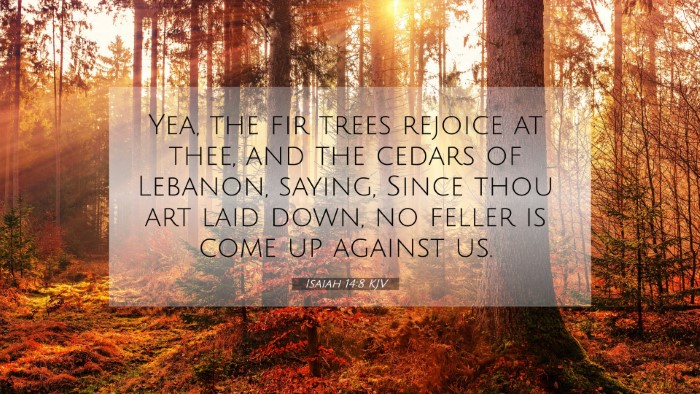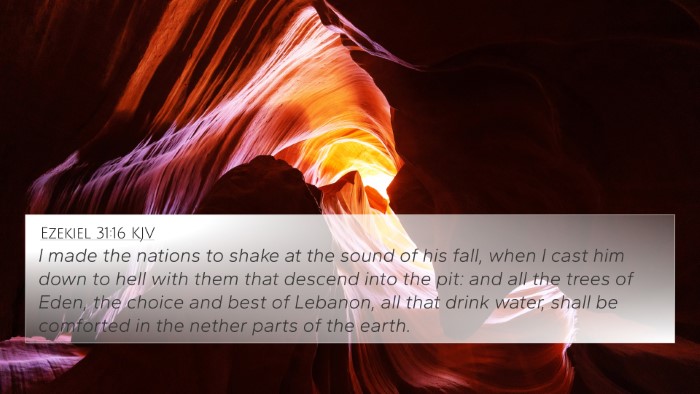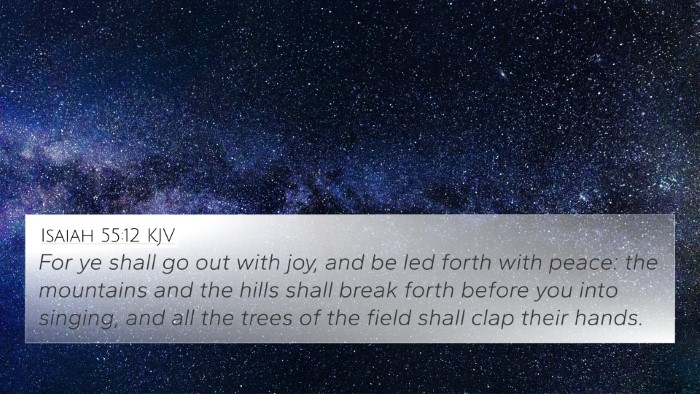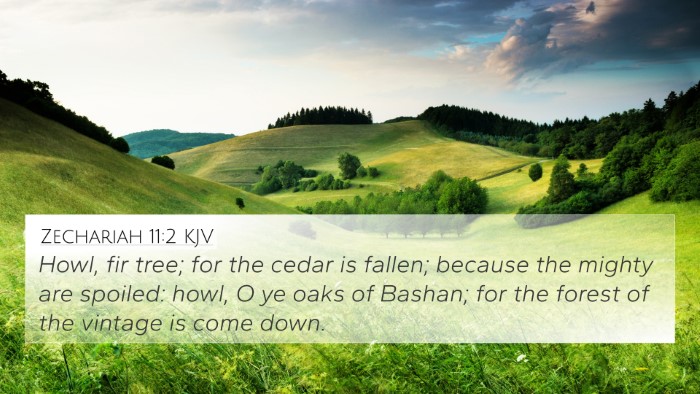Understanding Isaiah 14:8
Isaiah 14:8 states: "Yea, the fir trees rejoice at thee, and the cedars of Lebanon, saying, Since thou art laid down, no feller is come up against us."
Verse Context and Overview
This verse is situated within a larger passage that addresses the fall of the king of Babylon. It metaphorically presents nature, specifically the trees, rejoicing over the demise of this oppressive ruler. Scholars such as Matthew Henry, Albert Barnes, and Adam Clarke provide insights into this metaphor, emphasizing the relief and restoration that occurs in the natural world when tyranny is removed.
Meaning and Interpretation
-
Joy of Creation: The fir trees and cedars symbolize strength and longevity. Their joy signifies the restoration of peace and stability in creation when a tyrant is no longer in power.
-
Metaphorical Implications: The trees' rejoicing illustrates how oppressive rulers impact both humanity and nature. Their removal brings harmony back to society and the environment.
-
Divine Justice: The rejoicing of nature reflects God’s judgment upon the wicked. Commentators highlight that nature responds to divine actions, showcasing the connection between spiritual and natural realms.
Cross-References
Isaiah 14:8 connects with several other scriptures that reveal similar themes and motifs. Below are notable cross-references:
- Isaiah 11:6-7: The peaceable kingdom where the wolf and lamb lie together symbolizes restoration and the absence of oppression.
- Jeremiah 51:48: The heavens and earth will rejoice over Babylon’s downfall, paralleling nature's response in Isaiah 14.
- Ezekiel 28:17: This verse discusses the fall of the proud king of Tyre, indicating that downfall leads to restoration.
- Psalm 96:11-12: Creation rejoices in God's reign, reflecting the joy experienced at the end of tyranny.
- Revelation 18:20: Heaven is instructed to rejoice over Babylon's fall, tying the theme of divine justice across scripture.
- Romans 8:21: Creation itself anticipates liberation from corruption, resonating with the themes of restoration in Isaiah.
- Matthew 24:30: The coming of the Son of Man is marked by cosmic signs, indicating God's intervention in history.
- Isaiah 35:1-2: The wilderness and dry land shall rejoice, emphasizing creation’s response to divine action.
- Job 38:7: The morning stars sang together at creation, illustrating the theme of creation rejoicing at significant events.
- Luke 19:40: Jesus indicates that if His disciples were silent, the stones would cry out, showing the responsiveness of creation to God's actions.
Thematic Bible Verse Connections
The verse can be connected to various biblical themes such as:
- Judgment and Restoration: Many scriptures explore the cycle of divine judgment leading to restoration and peace.
- Nature’s Response to Divine Action: Several verses highlight how creation reacts to both judgment and salvation.
- The Role of Kings and Authority: The relationship between rulers and their impact on creation and society is a recurring theme.
- Prophetic Literature: Isaiah often describes the consequences of political actions through imagery and metaphor, a common feature in prophetic texts.
Insights from Commentaries
The commentaries from Matthew Henry emphasize the irony of the trees rejoicing, noting that they had been under threat during the king’s reign. Albert Barnes focuses on the imagery, illustrating how the natural world reflects reactions to human events. Similarly, Adam Clarke points out the dual nature of this message: both a literal interpretation regarding Babylon and a spiritual understanding of God's ultimate authority over earthly powers.
Tools for Bible Cross-Referencing
For further exploration of cross-references and deeper understanding, consider using the following tools:
- Bible Concordance: A comprehensive tool that helps locate verses and themes.
- Bible Cross-Reference Guide: A guide to identify scripture connections.
- Cross-Reference Bible Study: Engage in a methodical study that involves linking thematic verses.
- Bible Reference Resources: Utilize software or print resources that catalog verse connections.
- Comprehensive Bible Cross-Reference Materials: Search for works that consolidate multiple scripture references on themes.
Conclusion
Isaiah 14:8 encapsulates profound themes of judgment, restoration, and the joy of creation in response to the removal of tyranny. Through scriptural cross-referencing, one can gain deeper insights into the connections and parallels found throughout the Bible. This holistic approach to understanding scripture underscores the importance of context and the interconnectedness of God's Word.
